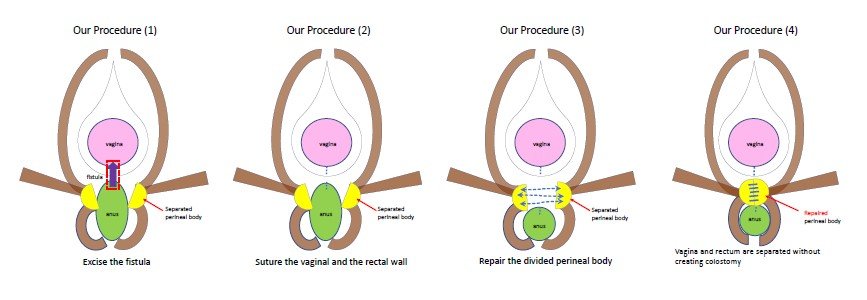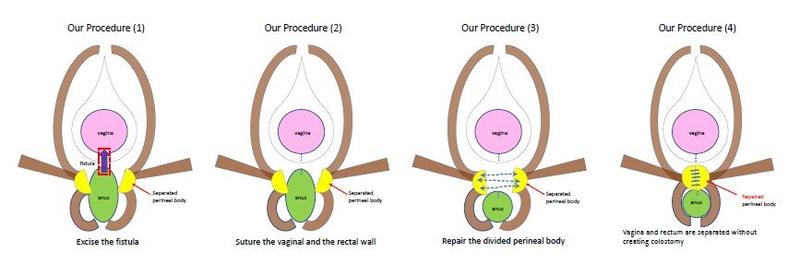Japanese / English
"Rectovaginal Fistula" and "Anal Sphincter Dysfunction"
Treatment of "Rectovaginal Fistula" and "Anal Sphincter Dysfunction" without the need for Colostomy Surgery
A message to those of you suffering from vaginal dysfunction
It is estimated that 1 in 10,000 women will develop a rectovaginal fistula or anal sphincter dysfunction as a consequence of vaginal delivery. These conditions are typically caused by similar mechanisms. Given that there are approximately 700,000 births per year in Japan, with about 500,000 being vaginal deliveries, it is projected that around 50 new cases occur annually. It is probable that many patients remain untreated due to the inability to communicate their symptoms. If left unaddressed, these symptoms may lead to additional complications, such as depression from anxiety or difficulties in relationships with partners. Therefore, we advise you to consult a physician and consider surgical intervention as soon as possible.
Rectovaginal Fistula
What is "rectovaginal fistula"?
Rectovaginal fistula is a condition characterized by perineal damage following vaginal delivery, resulting in the formation of a fistula, or abnormal passage, between the vagina and rectum. This anomaly can cause an unintended connection between the vagina and rectum, leading to the leakage of gas or stool from the vagina. Leakage is particularly prevalent during episodes of loose stools, such as diarrhea, and the frequency varies among individuals, depending on the extent of the laceration. Additional symptoms may include urinary incontinence, pain during defecation or sexual intercourse, and bacterial infections from the leaked stool, which can sometimes be transmitted to the partner. Due to the lack of widespread awareness about this condition, many patients remain uncertain about whether to consult a gynecologist or a proctologist, or are unable to seek advice from anyone.
Treatment of rectovaginal fistula in hospitals other than ours in Japan
Minor (1st and 2nd degree) perineal tears resulting from childbirth can typically be completely healed with sutures. However, if the muscle is torn or the laceration extends into the rectum (3rd and 4th degree), a rectovaginal fistula may develop. Additionally, cancer, cancer surgery, and inflammatory bowel disease may also precipitate the formation of a rectovaginal fistula. Our treatment approach involves surgery if the cause is a perineal tear due to delivery, but if the etiology is cancer or bowel disease, surgery is not indicated at our hospital.
There are several surgical techniques available, but in contemporary Japan, most medical facilities opt for excision and closure of the fistula. Nonetheless, this method has a high recurrence rate and may necessitate a colostomy. Furthermore, in most cases, a cesarean section is recommended for subsequent childbirth following the surgery.
Our Surgical procedure for Rectovaginal fistula
Unlike the general treatment described above, we perform surgery to suture and reconstruct the torn perineal body. Under lumbar anesthesia, a scalpel is inserted between the rectum and vagina with the patient in the jackknife position (lying on the bed with the buttocks elevated). The rectal and vaginal walls are meticulously separated, and the dissected perineal body is identified on both sides and sutured. This delicate procedure typically takes about two hours to complete at our institute. The condition of the vaginal tissue varies among patients, but the same surgical technique is generally employed. The patient can start eating the day after surgery and is usually discharged from the hospital approximately seven days postoperatively. There is no need for a colostomy or prolonged fasting, and some patients have even delivered vaginally again following the surgery.

Anal sphincter dysfunction
What is “anal sphincter dysfunction”?
Anal sphincter dysfunction is a condition characterized by the weakening of the anal sphincter muscle, resulting in the involuntary leakage of stool and gas. This weakening is often attributed to age-related loosening of the sphincter, but it can also be caused by neurological disorders such as spinal cord disease or by perineal tears resulting from vaginal delivery.
Our Surgical procedure for anal sphincter dysfunction
In cases where the dysfunction is caused by perineal laceration due to vaginal delivery, perineal body reconstruction surgery can restore the function of the anal sphincter muscle attached to the perineal body, similar to the treatment for rectovaginal fistula. The surgical procedure is nearly identical to that used for rectovaginal fistula.
Generally, the most common treatment for anal sphincter dysfunction is a procedure called "overwrapping," where the severed muscle is located and stitched over. However, this method has a high recurrence rate and may necessitate a colostomy. In addition to colostomy, some medical facilities also provide other treatments such as fasting, intravenous hyperalimentation, and prolonged hospitalization, which can be both financially and time-consuming for the patient. However, when the cause is clearly a perineal fissure, there is no need for CT, MRI, or other exams that may be burdensome to the patient. Perineal body reconstruction surgery offers a less financially and time-consuming treatment option.
Conclusion
For approximately 30 years, Dr. Kyozo Hashimoto of Hashimoto Clinic (closed in May 2024) in Nagaokakyo City and Dr. Tomoyuki Mizukuro, the chairperson of our hospital, have been refining a surgical technique that avoids the creation of a colostomy, eliminates the need for long-term fasting, and minimizes physical and psychological stress on the patient. Consequently, patients from across Japan, spanning from Tohoku to Okinawa, seek surgical treatment at our facility. Please do not bear this burden alone. Consult with our hospital, which has the highest number of cases in Japan. If you have any questions or concerns, please contact us. While we aim to respond promptly, we may not be able to do so during Japanese nighttime or on holidays.
Responsibility in writing: Koichiro Murakami
Surgical Cases at Our Hospital since 2000





